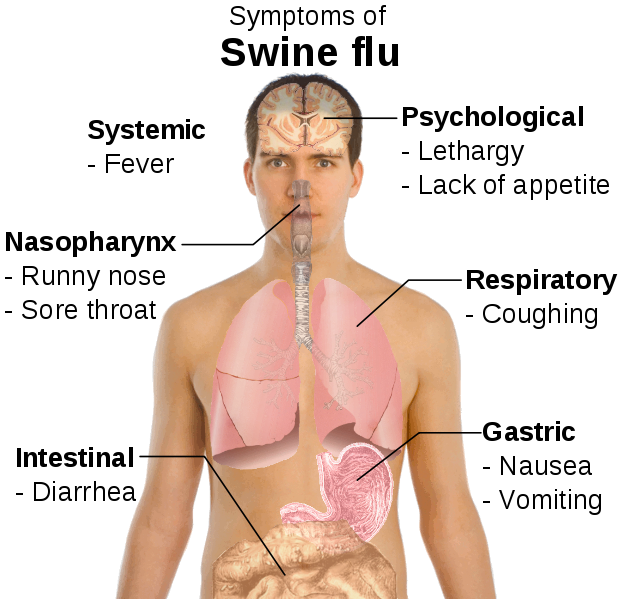
cdc.gov/h1n1flu/swineflu_you.htmcdc.gov/h1n1flu/swineflu_you.htm
The CDC site will tell you quite a bit Ive been staying updated there.
But here's what they say
"The symptoms of swine flu in people are similar to the symptoms of regular human flu and include fever, cough, sore throat, body aches, headache, chills and fatigue. Some people have reported diarrhea and vomiting associated with swine flu. In the past, severe illness (pneumonia and respiratory failure) and deaths have been reported with swine flu infection in people. Like seasonal flu, swine flu may cause a worsening of underlying chronic medical conditions."
It's only deadly if not treated.
Severe head-ache, nausea, diarrhea, vomiting, Abdominal pains are the main symptoms. Secondary symptoms include: fainting, coughing, chills, fatigue, and sudden bursts of heat
Treatment includes: bed rest and lots of fluids.
Mostly these answers are right but it can be deadly even if treated so that info is wrong.
Additional info:
CHICAGO – Paris Hilton says "I don't eat that" when asked about swine flu in an online video. She's not the only one confused about the outbreak.
Others have vowed to stop eating pork. Some, worried about germs spreading in confined spaces, won't fly — anywhere. Or they think petting zoos and farm visits are off limits.
Like the swine flu itself, misinformation is spreading like a virus across the Internet, around the watercooler and across the backyard fence. here are some facts to dispel myths about swine flu.
Q: Should I avoid pork?
A: There's no evidence that swine flu spreads through pork. while it's important to cook it properly to protect against other germs, experts say even handling raw pork poses no realistic risk of swine flu.
Q: what about airplanes — aren't airline cabins breeding grounds for germs?
A: Vice President Joe Biden suggested he believes that when he said Thursday he has advised his family not to fly. The federal Centers for Disease Control and Prevention advises against going to Mexico, the country hardest hit by swine flu. and public health officials say people with flu symptoms should avoid public transportation. But they aren't telling healthy people to avoid all air travel, and Obama administration representatives later said Biden had misspoken.
Most modern airliners have air filtering systems that are as efficient at weeding out germs as those used in hospital isolation units. while there have been occasional infectious disease outbreaks associated with airplane travel, they're not common, and generally only people within a few rows of the sick individual have gotten sick.
"we shouldn't go overboard" on limiting air travel, said Dr. mark Dworkin, an infectious disease specialist at the University of Illinois at Chicago. But he said it's a good idea to check the CDC's Web site before making travel plans because the agency's advisories may change as the outbreak develops.
Q: my child's preschool class is planning a visit to a petting zoo — with piglets. Should we skip it?
A: Dr. Kenneth Alexander, the University of Chicago's pediatric infectious disease chief, says there's no danger in touching pigs, although a sneezing, sick-looking animal should be avoided. Adults also should be vigilant about making sure kids keep their hands away from their faces after contact with farm animals and they should always wash their hands thoroughly afterward.
Q: my child is healthy and there are no reports of flu at her school, but I'd feel more comfortable keeping her home for a while.
A: Right now, public health authorities say there's no reason to restrict healthy children if there's no flu at school. that could change if the outbreak turns into a global pandemic.
Q: if this outbreak is declared a real worldwide pandemic, tens of millions will get sick and die, just like in the 1918 Spanish flu — right?
A: Public health officials say there are a lot of reasons why that's unlikely, at least in the United States. unlike that crisis, we now have flu-fighting medicines and antibiotics for secondary infections such as pneumonia, which killed many people during the 1918 outbreak.
Because it appears to be a novel flu strain, everyone exposed to the virus is at risk of getting sick. Authorities are trying to determine how aggressive the new flu is, but even if it turns out to be a particularly dangerous strain, the United States and other developed countries have a strong surveillance network and comprehensive public health measures that didn't exist in 1918, Dworkin noted.
If the new flu turns out to be similar to regular seasonal flu, as some authorities predict, Dworkin said it might double the number of illnesses and deaths seen in an average flu season. In the United States, that would mean about 70,000 deaths and more than 400,000 hospitalizations.
In developing nations, without strong public health networks, the situation could be more dire.
"It could do much more harm than we would see in a country like ours," Dworkin said.
___
On the Net:
cdc.gov/swineflu
wwwn.cdc.gov/travel/contentSwineF…